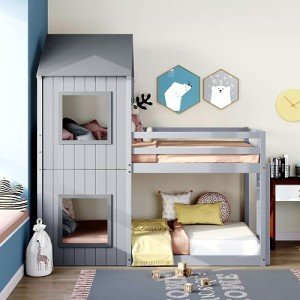Why You Should Focus On Improving Bunk Beds
Exploring Bunk Beds: A Comprehensive Guide
Bunk beds have actually long been a staple in children's bedrooms, dorms, and even homes with minimal space. Not only do they offer a practical sleeping solution, but they also develop an enjoyable and imaginative environment for children and a great space-saver for adults and families. This post will check out everything you need to know about bunk beds, from types and products to safety suggestions and purchasing recommendations.
Tabulation
- Types of Bunk Beds
- Traditional Bunk Beds
- Loft Beds
- Triple Bunk Beds
- L-Shaped Bunk Beds
- Product Options
- Wood
- Metal
- Security Considerations
- Buying Guide
- FAQs
Kinds Of Bunk Beds
Bunk beds come in numerous designs to match various requirements and preferences. Here's a breakdown of the most typical types:
Conventional Bunk Beds
Standard bunks generally include two beds stacked vertically on top of one another. These beds are perfect for siblings sharing a space or for taking full advantage of sleeping space in guest spaces.
Loft Beds
Loft beds stand likewise to conventional bunk beds but do not have a lower sleeping area. Rather, they frequently integrate a desk or seating location beneath, making them a great option for small rooms requiring multifunctionality.
Triple Bunk Beds
Triple bunk beds are developed for 3 residents, with beds stacked in a three-tier configuration. These are less typical but can be an enjoyable option for big families or slumber parties.
L-Shaped Bunk Beds
With one bed positioned horizontally and the other vertically, L-shaped bunk beds are frequently geared up with additional functions such as desks or storage drawers and can match corner spaces in a room.
Contrast of Bunk Bed Types
Bed Type
Suitable Use
Description
Traditional
Shared bed rooms or visitor rooms
Two beds stacked vertically
Loft
Little rooms requiring multi-purpose space
Upper bed with open space underneath
Triple
Big families or sleepovers
Three beds stacked vertically
L-Shaped
Corner or versatile areas
A combination of vertical and horizontal beds
Material Options
Bunk beds are made from various products, with wood and metal being the most typical. josiealexander.top has its pros and cons.
Wood
- Sturdiness: Generally robust and can endure years of usage.
- Aesthetic Appeal: Offers a traditional appearance that can blend with different decors.
- Weight Capacity: Typically tougher; can support much heavier weights.
- Downsides: May be more costly than metal alternatives and can be prone to scratches.
Metal
- Sturdiness: Generally lightweight and simple to move but still tough.
- Modern Design: Often is available in streamlined styles, making it appealing for modern spaces.
- Cost-efficient: Usually more economical than wooden alternatives.
- Drawbacks: Can be cold to the touch in winters and may not have the same visual appeal for some buyers.
Safety Considerations
When it concerns bunk beds, security can not be overlooked. Here are key safety suggestions to keep in mind:
- Guardrails: Ensure that the top bunk has guardrails on both sides to prevent falls.
- Sturdy Construction: Check for a solid develop and strong products to endure weight and movement.
- Weight Limit: Adhere to the maker's weight limit for both the upper and lower bunks.
- Ladder Design: Choose bunks with a safe, easy-to-climb ladder and avoid any sharp edges or rungs.
- Age Restrictions: Most makers advise that kids under the age of six need to not sleep in the upper bunk.
Purchasing Guide
When searching for bunk beds, consider the following factors to discover the best fit for your requirements:
- Space Availability: Measure the space size and ceiling height, guaranteeing there is appropriate space for the top bunk.
- Bed Size: Decide between twin, complete, or larger sizes based on your requirements and the size of the room.
- Style Preference: Consider the overall decoration of the bed room to discover an ideal design.
- Reduce of Setup: Look for a bunk bed that is straightforward to assemble.
- Spending plan: Bunk beds can be found in various rate ranges, so identify a budget before starting your search.
FAQs
1. What is the recommended age for kids to sleep on the leading bunk?
Children aged 6 and older are generally recommended to sleep on the leading bunk to minimize the danger of falls.
2. How can I make my bunk bed safer?
To enhance security, ensure guardrails are appropriately installed and examine that the bed is positioned on a flat surface area. Furthermore, encourage kids to use the ladder thoroughly.
3. Can I convert a bunk bed into two separate beds?
Lots of bunk beds are created to be convertible. Examine the maker's specifications for convertibility functions.
4. What devices are offered for bunk beds?
Typical devices include bed linens, storage drawers, staircases rather of ladders, and tented canopies for an enjoyable visual appeal.
5. How do I maintain my bunk bed?
Routine checks for loose screws or structural integrity can assist guarantee safety. Dust the bed routinely and tidy spills promptly to keep the materials in good condition.
Bunk beds are flexible and a space-efficient solution for different living scenarios, from children's spaces to guest lodgings. With many designs and materials readily available, possible purchasers have a wealth of options to consider, making sure a mix of practicality and aesthetics. By prioritizing security and following the tips outlined in this guide, people can discover the best bunk bed that suits their space and lifestyle, all while developing a pleasurable sleeping environment.
